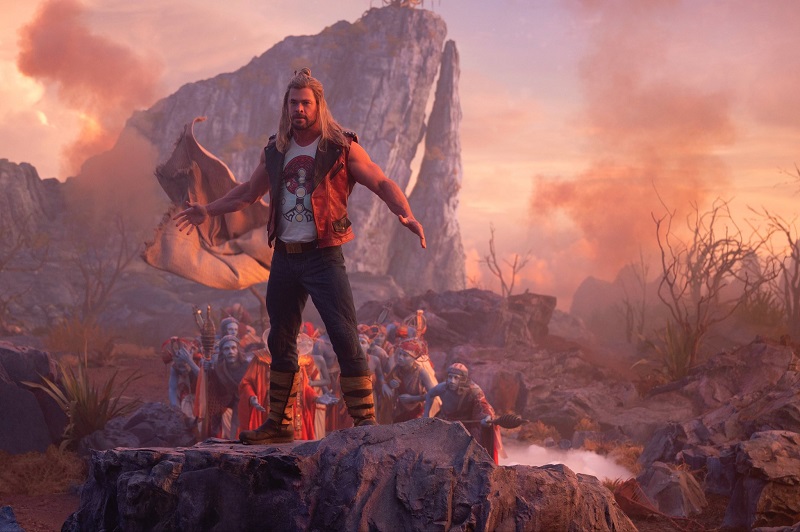Thor: Love and Thunder – 3 stars out of 4
For the “Thor: Love and Thunder” soundtrack, director Taika Waititi uses Guns ‘n Roses the same way he used Led Zeppelin for “Thor: Ragnarok” in 2017. Guns ‘n Roses was a great band, far superior to most all its peers, but it was no Led Zeppelin. And “Love and Thunder,” for all its zany chaos, is no “Ragnarok.”
“Love and Thunder” picks up in the aftermath of 2019’s “Endgame,” which left the titular demigod hero teaming up with the Guardians of the Galaxy for some outer space adventures. When we catch up with the gang, a cheeky voiceover from rock monster Korg (still voiced by Waititi) tells us how Thor (Chris Hemsworth) has shed his post-“Infinity War” beer gut and now acts as a literal Deux ex Machina for the Guardians whenever they find themselves overmatched against some interstellar foe.
The story gets going once the crew decides it’s time to part ways, and the Guardians set off on what will presumably form the plot of their third movie. Thor, for his part, has a more personalized foe to deal with. A mysterious villain named Gorr the God Butcher (Christian Bale) has been slaughtering Thor’s fellow demi-gods, and even kidnapped some of the Asgardian younglings. So our blonde-locked hero recruits some old friends—like Korg and Valkyrie (Tessa Thompson)–to face the new threat.
In the process, he meets up with his old girlfriend, Jane Foster (Natalie Portman), who has taken up Thor’s old hammer Mjolnir and transformed into a new hero dubbed The Mighty Thor. What Thor doesn’t know is that Jane is dying of cancer, and only using the hammer to postpone the inevitable.
In the meantime, everyone is getting in on the weapon game. Thor is still swinging his Stormbreaker axe, and to take on Gorr, he and Valkryie conspire to get a magic lightning bolt from Zeus (Russell Crowe) when their appeal for the Greek god’s help falls on mocking ears. Even Gorr is weapon-dependent. He’s only able to slaughter demigods because of a magic sword that came to him when his own deity let his daughter die of starvation.
What’s strange about all this underscores one of “Love and Thunder’s” weaknesses. One of the main points of “Ragnarok” was to show Thor that his powers weren’t rooted in his hammer, or any other weapon. The power was in himself. Yet throughout “Love and Thunder,” the fixation on Stormbreaker, Mjolnir, and the others—while it lends plenty of opportunity for laughs—seems to ignore that point.
The bigger issue is the way the humor—which reinvented (and arguably saved) the Thor franchise in “Ragnarok”—feels so jarring against the attempts for serious moments in “Love and Thunder.” Maybe it’s just because those “serious” moments try to carry more weight this time around—the mourning Gorr is substantially more imposing than “Ragnarok’s” megalomaniacal Hela (Cate Blanchett) on an emotional level—but the back and forth clashes awkwardly.
Even with those shortcomings, “Love and Thunder” still stands as an example of why Waititi and the Thor franchise loom head and shoulders above so much of what Marvel is producing in its post-“Endgame” meanderings. There are still plenty of references to other characters and situations, but witty dialogue and narration go a long ways toward keeping the audience on board, and the result is nowhere near the encyclopedic mess we just got with “Doctor Strange and the Multiverse of Madness.” Waititi still seems to be having a great time taking the piss out of the superhero genre, while simultaneously offering some of its most triumphant and outrageous moments. Even if “Love and Thunder” feels more like a sequel than a revelation, fans should enjoy the ride.
“Thor: Love and Thunder” is rated PG-13 for chaotic superhero mayhem and violence, as well as some sexual content (Hemsworth’s bare backside, played for laughs).

